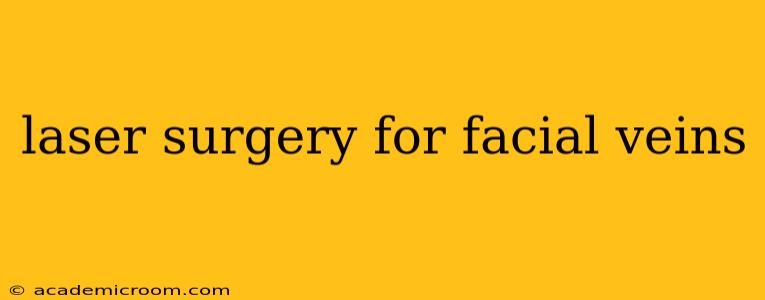Facial veins, those tiny, sometimes spider-like, red or purple lines on your face, can be a source of frustration for many. While often harmless, they can impact self-confidence and overall appearance. Laser surgery has emerged as a leading treatment option, offering a minimally invasive approach to diminish or eliminate these bothersome vessels. This comprehensive guide delves into the specifics of laser surgery for facial veins, addressing common questions and concerns.
What is Laser Surgery for Facial Veins?
Laser surgery for facial veins, also known as laser vein therapy or laser facial rejuvenation, utilizes intense pulsed light (IPL) or specific wavelengths of laser energy to target and destroy unwanted blood vessels. The laser's heat energy causes the blood vessels to collapse and eventually fade from view. The surrounding skin remains largely unaffected, making it a relatively precise and safe procedure. The specific type of laser used depends on the size, depth, and location of the veins.
What are the Different Types of Lasers Used?
Several laser technologies are employed to treat facial veins, each with its own advantages:
- Nd:YAG laser: This laser is particularly effective for treating larger veins located deeper in the skin. Its longer wavelength allows for deeper penetration.
- IPL (Intense Pulsed Light): IPL isn't strictly a laser, but it uses broad-spectrum light to target a range of skin imperfections, including facial veins. It's often preferred for treating superficial telangiectasias (small, dilated blood vessels).
- Dye lasers: These lasers are highly specific to hemoglobin, the protein in red blood cells, making them very effective in targeting blood vessels while minimizing damage to the surrounding tissue.
The choice of laser will depend on your individual needs and the characteristics of your facial veins, as determined by a consultation with a dermatologist or cosmetic surgeon.
How Long Does Laser Vein Treatment Take?
The duration of the procedure varies depending on the extent of the treatment area and the number of veins being treated. For small areas, a session may only take a few minutes, while larger areas could require 30 minutes or more. Multiple treatment sessions may be necessary for optimal results.
What is the Recovery Time After Laser Vein Treatment?
Recovery time is generally minimal. You may experience some mild redness, swelling, or bruising at the treatment site, which typically subsides within a few days. Avoid sun exposure and apply sunscreen diligently to protect the treated area. Make-up can usually be applied after a few hours. Your dermatologist will provide specific post-treatment care instructions.
Does Laser Vein Treatment Hurt?
Most patients describe the sensation during the procedure as a mild stinging or snapping feeling. A topical anesthetic cream may be applied beforehand to minimize any discomfort.
How Many Treatments are Typically Needed?
The number of treatments required varies from person to person. Some individuals may see significant improvement after a single treatment, while others may require multiple sessions spaced several weeks apart. Your dermatologist will develop a personalized treatment plan based on your specific needs.
What are the Potential Side Effects of Laser Vein Treatment?
While generally safe, potential side effects include temporary redness, swelling, bruising, and crusting at the treatment sites. Rarely, hyperpigmentation (darkening of the skin) or hypopigmentation (lightening of the skin) can occur. A qualified dermatologist will discuss these possibilities and take steps to minimize risks.
Is Laser Treatment for Facial Veins Permanent?
While the results of laser vein treatment are often long-lasting, it is not a permanent solution. New blood vessels can develop over time, so maintenance treatments may be necessary to maintain optimal results.
How Much Does Laser Vein Treatment Cost?
The cost of laser vein treatment varies depending on several factors, including the size of the treatment area, the number of sessions required, and the geographic location. It's best to consult with a dermatologist or cosmetic surgeon for an accurate price quote.
Disclaimer: This information is for general knowledge and informational purposes only, and does not constitute medical advice. Always consult with a qualified dermatologist or medical professional for personalized advice and treatment options.
